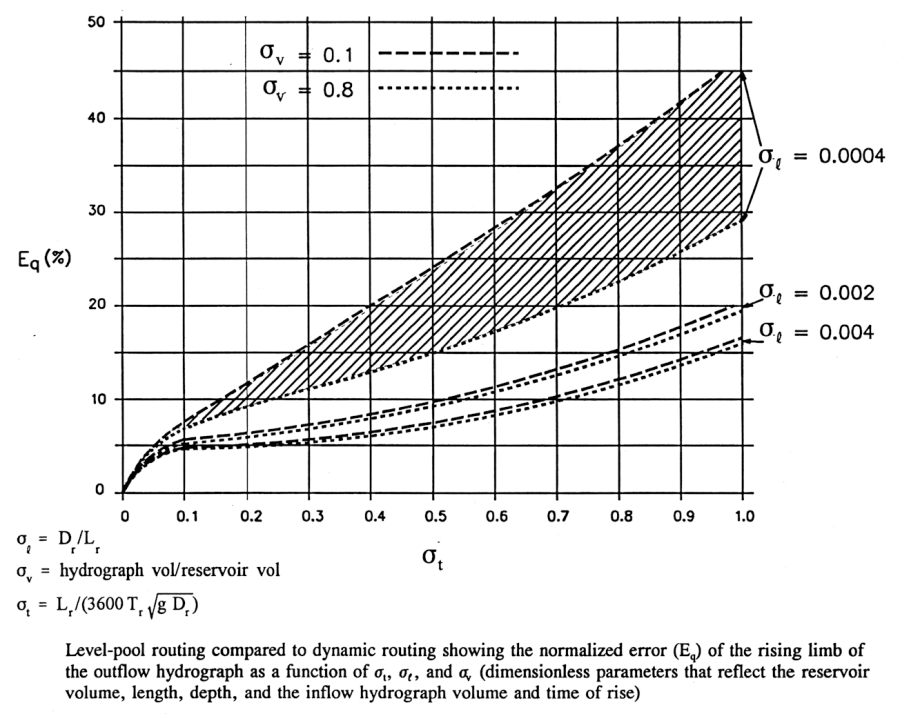Download PDF
Download page Inflow Flood Routing a Through Reservoir.
Inflow Flood Routing a Through Reservoir
HEC-RAS can be used to route an inflowing flood hydrograph through a reservoir with any of the following three methods: one-dimensional (1D) unsteady flow routing (full Saint Venant equations); two-dimensional (2D) unsteady flow routing (Full Saint Venant equations or Diffusion wave equations); or with level pool routing. In general, full unsteady flow routing (1D or 2D) will be more accurate for both the with and without breach scenarios. This method can capture the water surface slope through the pool as the inflowing hydrograph arrives, as well as the change in water surface slope that occurs during a breach of the dam. Reservoirs with long narrow pools will exhibit greater water surface slope upstream of the dam than reservoirs that are wide and short. Therefore, the most accurate modeling technique to capture pool elevations and outflows of long narrow reservoirs is full dynamic wave (unsteady flow) routing. For wide and short reservoirs, level pool routing may be appropriate.
Several items must be taken into account before choosing the appropriate flood routing technique for a given study:
- In situations where the population at risk and any damage centers are far enough downstream, differences in peak outflow and the shape of the breach hydrograph may not be significant by the time the flood wave reaches the downstream locations. Two hydrographs that have the same volume, but different peak flows and shape, will tend to converge as they are routed downstream through the river and floodplain. In this situation, the reservoir can be modeled with either full unsteady flow routing or level pool routing.
- The ability to acquire accurate cross section data through the pool can be problematic. Detailed bathymetric surveys may be required to accurately describe the elevation-volume relationship of the reservoir pool. If detailed bathymetric data are not available, and full unsteady-flow routing is still desired, cross section data can be modified to match the published elevation-volume curve of the reservoir pool. This can be accomplished by running a series of steady flow profiles from the dam to the upstream end of the pool, using a small flow and varying the downstream starting condition for different pool elevations. HEC-RAS will compute the volume under each profile. The elevation-volume curve computed by HEC-RAS can then be compared to the published curve. Start with the lowest elevations. If the computed volume does not match the published volume, the cross sections should be modified to increase or decrease the volume required. The Channel Design/Modification Editor in HEC-RAS may prove very useful for this task.
- Capturing the full reservoir volume upstream of the dam will require the modeler to extend cross sections far enough upstream, such that the invert elevation of the most upstream cross section is higher than the highest elevation that will be modeled in the dam during the largest event. Rough guidance would be to add a few feet to the top of the dam, and then extend the model upstream far enough so that the most upstream cross sections invert is higher than that elevation.
- If there are significant numbers of tributaries, or some large tributaries upstream of the dam that enter the pool directly, then storage volume due to backwater up the tributaries must be accounted for as well as their inflows. Tributaries can be modeled in several manners. One option is to model all of the significant tributaries as separate river reaches, using cross sections. A second option is to model the tributaries as storage areas, and connect those storage areas to the main pool with a lateral structure (weir). This will allow water to back up into the tributary as a level pool of water, thus accounting for its volume. A third option is to extend the reservoir cross sections up the tributaries and define that portion of the reservoir cross section as an ineffective flow area.
The differences between level pool routing and full unsteady flow routing through a reservoir can be very difficult to quantify. In order to decide if level pool routing is adequate, it is helpful to estimate the potential error in the peak flow of the routed outflow hydrograph, due to the use of level pool routing. Dr. Danny Fread (National Weather Service) performed several numerical experiments in which he compared both full dynamic wave routing to level pool routing (Fread, 2006). From these experiments he developed a set of equations and a graph that can be used to estimate the error in using level pool routing for a given reservoir and flood event. The graph and equations are shown below in the figure below (Fread, 2006). 
Where:
D = the average depth of water in the reservoir (ft). Approximated as Dmax/2
L_r = The length of the reservoir pool in feet
T_r = The time of rise if the inflowing hydrograph in hours
In order to use the figure above, the user must calculate σl, σv, and σt. Once these three parameters are calculated, a percent error in the rising limb/peak flow of the outflow hydrograph can be estimated. This error represents the difference in the answers between using level pool routing and full dynamic wave routing.